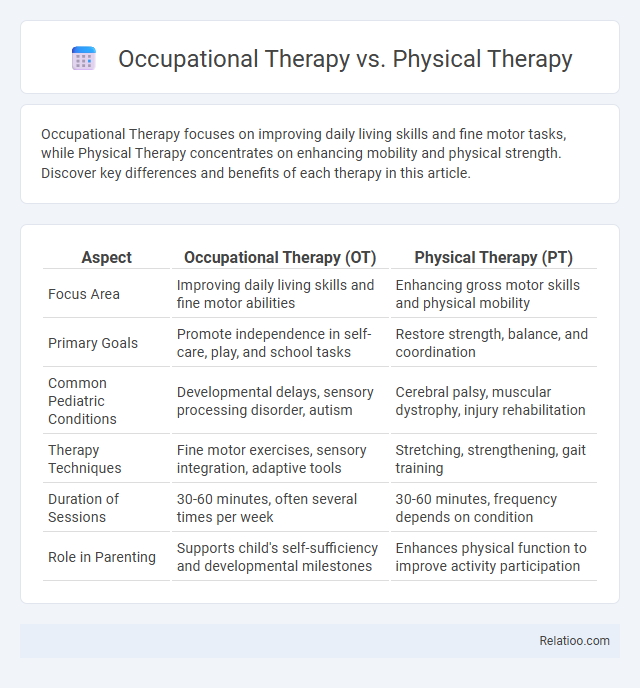Occupational Therapy focuses on improving daily living skills and fine motor tasks, while Physical Therapy concentrates on enhancing mobility and physical strength. Discover key differences and benefits of each therapy in this article.
Table of Comparison
| Aspect | Occupational Therapy (OT) | Physical Therapy (PT) |
|---|---|---|
| Focus Area | Improving daily living skills and fine motor abilities | Enhancing gross motor skills and physical mobility |
| Primary Goals | Promote independence in self-care, play, and school tasks | Restore strength, balance, and coordination |
| Common Pediatric Conditions | Developmental delays, sensory processing disorder, autism | Cerebral palsy, muscular dystrophy, injury rehabilitation |
| Therapy Techniques | Fine motor exercises, sensory integration, adaptive tools | Stretching, strengthening, gait training |
| Duration of Sessions | 30-60 minutes, often several times per week | 30-60 minutes, frequency depends on condition |
| Role in Parenting | Supports child's self-sufficiency and developmental milestones | Enhances physical function to improve activity participation |
Introduction to Occupational Therapy and Physical Therapy
Occupational therapy focuses on helping individuals develop, recover, or maintain daily living and work skills, promoting independence in your everyday activities. Physical therapy emphasizes improving movement, strength, and mobility through targeted exercises and treatments, addressing physical impairments. Both therapies play a crucial role in supporting special needs populations by tailoring interventions to enhance functional abilities and quality of life.
Defining Occupational Therapy
Occupational Therapy (OT) focuses on helping individuals develop, recover, or maintain daily living and work skills through therapeutic activities tailored to their specific needs. Unlike Physical Therapy, which primarily addresses physical movement and pain management, OT emphasizes improving cognitive, sensory, and motor skills to enhance independence in everyday tasks. Special needs therapy often incorporates OT techniques to support children and adults with developmental delays or disabilities in achieving functional goals.
Defining Physical Therapy
Physical Therapy emphasizes restoring movement and function through exercises, manual therapy, and modalities to treat injuries, chronic conditions, and disabilities. Occupational Therapy focuses on helping individuals perform daily activities and improve fine motor skills for independent living. Special needs therapy involves tailored interventions to support developmental, cognitive, or physical challenges unique to each individual.
Key Differences Between Occupational Therapy and Physical Therapy
Occupational therapy primarily addresses improving patients' ability to perform daily living activities and fine motor skills, often focusing on cognitive and sensory integration. Physical therapy emphasizes restoring and enhancing gross motor function, mobility, and physical strength through exercises and manual therapy techniques. Special needs interventions may incorporate both therapies to provide comprehensive support tailored to individual developmental and functional challenges.
Common Goals of Occupational Therapy
Occupational Therapy focuses on enabling individuals to perform daily activities independently, addressing fine motor skills, cognitive function, and sensory processing to improve your quality of life. Common goals include enhancing self-care abilities, promoting adaptive techniques for everyday tasks, and facilitating participation in work or leisure activities. Unlike Physical Therapy, which targets gross motor skills and physical rehabilitation, Occupational Therapy emphasizes functional skills essential for personal and social independence, especially for individuals with special needs.
Common Goals of Physical Therapy
Physical Therapy primarily aims to restore mobility, alleviate pain, and improve physical function through targeted exercises, manual therapy, and adaptive techniques, benefiting patients with musculoskeletal injuries, neurological disorders, or chronic conditions. While Occupational Therapy focuses on enhancing daily living skills and Special Needs support specialized interventions for developmental or cognitive challenges, Physical Therapy centers on strengthening muscles and increasing range of motion. Your recovery plan may integrate these therapies, but Physical Therapy's common goals emphasize optimizing physical independence and functional movement.
Conditions Treated by Occupational Therapists
Occupational therapists specialize in treating conditions that affect daily living and work skills, such as developmental delays, stroke, traumatic brain injuries, and sensory processing disorders. Physical therapists focus primarily on improving movement, strength, and mobility for conditions like orthopedic injuries, arthritis, and post-surgical recovery. For your child with special needs, occupational therapy enhances fine motor skills, cognitive functions, and adaptive techniques to support independence and quality of life.
Conditions Treated by Physical Therapists
Physical therapists specialize in treating musculoskeletal conditions, neurological disorders, sports injuries, and post-surgical rehabilitation to improve mobility, reduce pain, and restore function. Unlike occupational therapy, which focuses on enhancing daily living skills, physical therapy targets physical impairments related to conditions such as stroke, arthritis, spinal cord injuries, and orthopedic injuries. Special needs therapy may incorporate both approaches but physical therapists primarily address movement deficits and physical rehabilitation.
How to Choose Between Occupational and Physical Therapy
Choosing between occupational therapy and physical therapy depends on specific patient goals and challenges; occupational therapy emphasizes improving daily living skills and fine motor coordination, while physical therapy targets mobility, strength, and pain reduction. Patients with special needs benefit from tailored interventions that combine elements of both therapies to enhance functional independence and quality of life. Consulting healthcare professionals to assess individual requirements ensures an effective therapeutic approach aligned with personal health objectives.
Conclusion: Selecting the Right Therapy for Your Needs
Choosing between occupational therapy, physical therapy, and special needs services depends on your specific goals and challenges; occupational therapy enhances daily living skills, physical therapy improves mobility and strength, while special needs therapy addresses individualized developmental or learning disorders. Your therapist's expertise and a tailored treatment plan ensure effective progress. Evaluating your unique requirements and consulting healthcare professionals helps you select the right therapy for optimal outcomes.

Infographic: Occupational Therapy vs Physical Therapy
 relatioo.com
relatioo.com